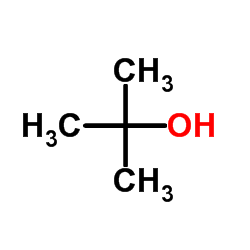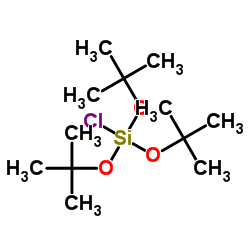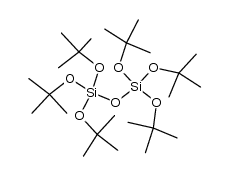18166-43-3
| Name | hydroxy-tris[(2-methylpropan-2-yl)oxy]silane |
|---|---|
| Synonyms |
Tri-tert-butyl hydrogen orthosilicate
MFCD00271024 Tri-t-butoxysilanol tri-tert-butoxysilanol Silicic acid (HSiO), tris(1,1-dimethylethyl) ester Si(OH)(OtBu)3 tri-tert-butylsilanol Tris(2-methyl-2-propanyl) hydrogen orthosilicate (tert-(C4H9O)3)SiOH tris-tert-butoxysilanol |
| Density | 0.9±0.1 g/cm3 |
|---|---|
| Boiling Point | 263.4±23.0 °C at 760 mmHg |
| Melting Point | 63-65ºC(lit.) |
| Molecular Formula | C12H28O4Si |
| Molecular Weight | 264.434 |
| Flash Point | 113.1±22.6 °C |
| Exact Mass | 264.175690 |
| PSA | 47.92000 |
| LogP | 6.08 |
| Vapour Pressure | 0.0±1.2 mmHg at 25°C |
| Index of Refraction | 1.436 |
| Storage condition | below 5° C |
|
Section 1: Product Identification Chemical Name:Tri-t-butoxysilanol (99.999%-Si) PURATREM CAS Registry Number:18166-43-3 Formula:[(CH3)3CO]3SiOH EINECS Number:none Chemical Family:organosilicon compound Synonym:Tris(tert-butoxy)silanol
Section 2: Composition and Information on Ingredients IngredientCAS NumberPercentACGIH (TWA)OSHA (PEL) Title compound18166-43-3100%no datano data Section 3: Hazards Identification Emergency Overview:Irritating to skin, eyes and respiratory tract. Primary Routes of Exposure:Ingestion, inhalation, eyes Eye Contact:Causes slight to mild irritation of the eyes. Skin Contact:Causes slight to mild irritation of the skin. Inhalation:Irritating to the nose, mucous membranes and respiratory tract. Ingestion:No information available on the physiological effects of ingestion. May be harmful if swallowed. Acute Health Affects:Irritating to skin, eyes and respiratory tract. No information on long-term chronic effects. Contact with moisture, as resulting from human contact, will Chronic Health Affects: produce n-butanol which shows reproductive effects in animal studies. NTP:No IARC:No OSHA:No SECTION 4: First Aid Measures Immediately flush the eyes with copious amounts of water for at least 10-15 minutes. A victim may need Eye Exposure: assistance in keeping their eye lids open. Get immediate medical attention. Wash the affected area with water. Remove contaminated clothes if necessary. Seek medical assistance if Skin Exposure: irritation persists. Remove the victim to fresh air. Closely monitor the victim for signs of respiratory problems, such as difficulty Inhalation: in breathing, coughing, wheezing, or pain. In such cases seek immediate medical assistance. Seek medical attention immediately. Keep the victim calm. Give the victim water (only if conscious). Induce Ingestion: vomiting only if directed by medical personnel. SECTION 5: Fire Fighting Measures Flash Point:no data Autoignition Temperature:none Explosion Limits:none Extinguishing Medium:carbon dioxide, dry powder or foam If this product is involved in a fire, fire fighters should be equipped with a NIOSH approved positive pressure Special Fire Fighting Procedures: self-contained breathing apparatus and full protective clothing. Hazardous Combustion andIf involved in a fire this material may emit irritating fumes. Decomposion Products: Unusual Fire or Explosion Hazards: No unusual fire or explosion hazards. SECTION 6: Accidental Release Measures Small spills can be mixed with vermiculite, sodium carbonate or other suitable non-combustible adsorbent and Spill and Leak Procedures: swept up. SECTION 7: Handling and Storage Store in a tightly sealed container under an inert atmosphere of nitrogen or argon. Keep in a cool, dry, Handling and Storage: well-ventillated area. SECTION 8: Exposure Controls and Personal Protection Eye Protection:Always wear approved safety glasses when handling a chemical substance in the laboratory. Skin Protection:Wear protective clothing and gloves. Ventilation:Handle the material in an efficient fume hood. If ventilation is not available a respirator should be worn. The use of respirators requires a Respirator Respirator: Protection Program to be in compliance with 29 CFR 1910.134. Ventilation:Handle the material in an efficient fume hood. Additional Protection:No additional protection required. SECTION 9: Physical and Chemical Properties Color and Form:white solid Molecular Weight:264.43 Melting Point:63-65°C Boiling Point:205-210C Vapor Pressure:0.4mm @ 55? Specific Gravity:0.89g/cc3 Odor:none Solubility in Water:insoluble SECTION 10: Stability and Reactivity Stability:moisture sensitive Hazardous Polymerization:no hazardous polymerization Conditions to Avoid:prolonged exposure to moisture Incompatibility:strong oxidizing agents, strong acids and halogens Decomposition Products:carbon dioxide, carbon monoxide, organic fumes, butanol and silicon dioxide. SECTION 11: Toxicological Information RTECS Data:No information available in the RTECS files. Carcinogenic Effects:no data Mutagenic Effects:no data Tetratogenic Effects:no data SECTION 12: Ecological Information Ecological Information:No information available SECTION 13: Disposal Considerations Disposal:Dispose of according to local, state and federal regulations. SECTION 14: Transportation Shipping Name (CFR):Non-hazardous Hazard Class (CFR):NA Additional Hazard Class (CFR):NA Packaging Group (CFR):NA UN ID Number (CFR):NA Shipping Name (IATA):Non-hazardous Hazard Class (IATA):NA Additional Hazard Class (IATA):NA Packaging Group (IATA):NA UN ID Number (IATA):NA SECTION 15: Regulatory Information TSCA:Not listed in the TSCA inventory SARA (Title 313):Not reportable under SARA 313 Second Ingredient:none SECTION 16 - ADDITIONAL INFORMATION N/A |
| Personal Protective Equipment | Eyeshields;Gloves;type N95 (US);type P1 (EN143) respirator filter |
|---|---|
| Risk Phrases | 36/37/38 |
| Safety Phrases | 22-24/25 |
| RIDADR | NONH for all modes of transport |
| WGK Germany | 3 |
| HS Code | 2915900090 |
|
~% 
18166-43-3 |
| Literature: Inorganic Chemistry, , vol. 42, # 4 p. 1140 - 1150 |
|
~% 
18166-43-3 |
| Literature: Inorganic Chemistry, , vol. 42, # 4 p. 1140 - 1150 |
|
~% 
18166-43-3 |
| Literature: US2566956 , ; |
|
~% 
18166-43-3 |
| Literature: Rec. Trav. chim., , vol. 61, p. 500 - 512 |
|
~% 
18166-43-3 |
| Literature: Recueil des Travaux Chimiques des Pays-Bas, , vol. 61, p. 502 |
|
~% 
18166-43-3 |
| Literature: Inorganic Chemistry, , vol. 42, # 4 p. 1140 - 1150 |
|
~% 
18166-43-3 |
| Literature: Inorganic Chemistry, , vol. 42, # 4 p. 1140 - 1150 |
| HS Code | 2915900090 |
|---|---|
| Summary | 2915900090 other saturated acyclic monocarboxylic acids and their anhydrides, halides, peroxides and peroxyacids; their halogenated, sulphonated, nitrated or nitrosated derivatives VAT:17.0% Tax rebate rate:9.0% Supervision conditions:AB(certificate of inspection for goods inward,certificate of inspection for goods outward) MFN tariff:5.5% General tariff:30.0% |








